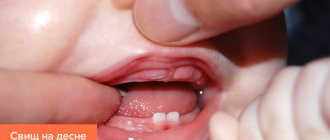June 14, 2021
Normally, the size and shape of the jaws may vary slightly in accordance with the characteristics of the shape and size of the face of each individual person. These small differences contain the uniqueness of each face, its unique personality and attractiveness. However, in some cases, when there is a sharp deviation of these values from the average parameters that conventionally correspond to the rest of the human face, we can talk about the presence of pathology. Such pathologies include anomalies in the size of the jaws, which we will discuss in detail in this article.
Causes of development of jaw size abnormalities. Definition of disease
Anomalies in the size of the jaws are expressed in defects in the structure of the jaw bone. These are functional and aesthetic defects affecting the upper or lower jaw . In mild forms of the pathology, the defect does not cause noticeable discomfort. However, serious size anomalies can noticeably distort facial proportions and cause problems with speech, breathing, chewing and swallowing food. Violations in the size of the jaws, their incorrect position in relation to the skull and, accordingly, uneven load on the joints, muscles and teeth often provoke the development of certain dental diseases and serious pathologies of the temporomandibular joint (TMJ).
Anomalies in jaw size are usually classified into the following types::
- Macrognathia (pathology is characterized by an unnaturally large jaw size). Macrognathia can be lower, upper or combined.
- Micrognathia (characterized by a reduced jaw size, its insufficient development). Micrognathia can also be lower, upper, or combined.
Various developmental disorders of the maxillofacial region, including anomalies of shape and/or size, are unfortunately quite common and significantly affect a person’s quality of life. The development of macrognathia or micrognathia can be caused by many factors, but genetics significantly predominates among them. Another common cause of such deformities may be environmental factors , a combination of genetic and environmental factors, or severe trauma .
Most often, jaw size anomalies are detected from birth, since in most cases micro- or macrognathia is a manifestation of hereditary diseases or a consequence of the harmful effects of adverse factors on the fetus during pregnancy.
! The main reasons for the development of dentofacial deformities include:
- Specific inheritance by a child of the anatomy of the dental system. The baby inherits from its parents not only external characteristics and body composition, but also the structure and size of the jaws and teeth. In some cases, teeth (their size, shape) can be inherited from the father, and the structure of the jaw bones from the mother, or vice versa. This can provoke developmental disorders and interfere with the formation of harmonious relationships between the jaws and dentition.
- Poor nutrition of a pregnant woman, neglect of a healthy lifestyle before and during pregnancy (smoking, alcohol), infectious diseases , taking certain medications.
- Unfavorable environmental conditions (a woman carrying a child or a newborn and a nursing mother is in an unfavorable environment (ultraviolet irradiation, increased radiation, mold spores, excess exhaust gases, the content of harmful elements and heavy metals in the air and water)
- Potentially dangerous diseases suffered by a child in infancy that can provoke deviations in the process of subsequent bone formation (rickets, osteoporosis, severe infectious or endocrine diseases, osteomyelitis).
- Disturbances in the infant's sucking process (unnatural latching on the breast, use of a pacifier of improper non-anatomical shape, excessively prolonged sucking of the pacifier or fingers, etc. can lead to pathological inclination of the dentition and improper development of the jaws); untreated diseases of baby teeth in a child (early loss of molars (chewing teeth) can cause a decrease in the activity of growth zones and, as a result, cause underdevelopment of the jaw bones)).
- Pathologies of the otorhinolaryngological system (chronic diseases of the nasopharynx, various rhinitis, sinusitis, etc. or abnormal structure of the nasal septum often lead to “mouth breathing” - a person constantly breathes exclusively through the mouth, which affects the tone of the orbicularis oris muscle, which in turn negatively affects growth upper jaw)
- Serious injuries to the head and facial area , consequences of incorrect surgical intervention in the maxillofacial area, etc.
TMJ functioning problems
| Click to sign up for a FREE consultation |
Disruption of the work and function of the joints and muscles of the lower jaw is called TMJ dysfunction. The pathology is caused by the occurrence of a defect in the teeth, increased wear and tear and an abnormal bite of a person.
The main clinical manifestation of dysfunction is clicking and clattering of teeth when opening the mouth. In more advanced cases, pain occurs in the ears, jaw, and painful sensations begin during chewing and yawning.
The main method for diagnosing TMJ dysfunction is radiography, which reveals dysfunction of the jaw and joint.
Treatment consists of a comprehensive effect on the condition of the jaw, which the dentist carries out based on knowledge of the biomechanics of its work.
Prevention of the development of micrognathia and macrognathia
Let's talk about possible measures to prevent the development of maxillofacial anomalies. Since the influence of negative factors on the health of the child’s future dental system is especially active during the mother’s pregnancy and in the first months of the baby’s life, preventive measures must be followed even before the birth of the child and in the first year of life . To promptly prevent the development of dentofacial deformities, you should adhere to the following:
- carefully monitor the course of pregnancy, try, if possible, to avoid the risk of infectious diseases of the expectant mother;
- try to avoid long stays of a pregnant woman, mother and baby in an unfavorable ecological environment;
- eat a nutritious and varied diet and lead a healthy lifestyle during pregnancy;
- give up bad habits in the process of planning pregnancy, during pregnancy and breastfeeding;
- adhere to proper feeding of the baby (use an anatomically correct nipple and discard it in a timely manner; when artificially feeding, make sure that the bottle with the mixture does not put pressure on the alveolar processes);
- if possible, stop bad habits (sucking and biting fingers and cheeks, tongue, various objects) that provoke deformations of the dentition, disturbances in the growth of the jaw bones;
- observe the timing and sequence of teething, monitor the development of speech;
- promptly identify and eliminate congenital pathologies in the form of a shortened frenulum, cleft lip, palate, etc.;
- wean the child from sucking fingers, objects, etc.;
- conduct myogymnastics with the child to prevent disorders of respiratory, swallowing, and speech functions; ensure that the child does not breathe through his mouth;
- timely treatment of baby teeth and periodontal diseases;
- adhere to preventive measures and promptly treat common diseases (rickets, diseases of the ENT organs, endocrine pathologies, etc.)
Thus, in the prevention and timely identification of risk factors that contribute to the occurrence of various dental anomalies, the most important thing is the active and careful participation of parents at all stages of the child’s growth and development.
Materials for bone tissue building in dentistry
Bone augmentation before dental implantation involves the use of different types of osteoplastic materials. Osteoplasty can be synthetic or natural; each type has its own characteristics and characteristics; the price of bone tissue augmentation and recovery time after surgery depend on the type of osteoplastic material. What types of osteoplasty for building up gum bone tissue during implantation can be offered to you in modern dentistry?
Autogenous osteoplasty for augmentation
This is the name given to bone material of biological origin, which is obtained directly from the patient. Donor osteoplasty is taken from certain areas of the jaw or chin. The process of obtaining donor bone is painful and traumatic, but the biomaterial quickly takes root, and its use does not cause complications or negative reactions of the immune system.
Allogeneic materials
The bone donor for dental bone tissue augmentation is another person, and not the patient himself. This type of osteoplasty is taken from deceased or deceased donors, subjected to specialized and complex processing and placed in donor tissue banks. To some, this method of obtaining bone material may seem unethical, however, the use of allogeneic osteoplasty reduces the risk of bone rejection, eliminates the need to collect material directly from the patient, and therefore reduces the traumatic nature of the operation as a whole.
Xenogeneic osteoplasty for building bone tissue on teeth
This type of osteoplastic material is obtained from porcine or bovine bone. It is available in the form of blocks or granules. Xenogeneic osteoplastics take root quite well, but still worse than allogeneic and autogenous materials.
Alloplastic osteoplasties
Granular synthetic osteomaterial made from calcium phosphate.
Its main advantage is its affordable price, which reduces the cost of bone tissue augmentation. A separate type of osteoplastics used in bone tissue augmentation are collagen membranes, which isolate the bone defect and activate the processes of growth of natural jaw bone.
Surgery. Forecast
The doctor assesses the need for correction of macrognathia and micrognathia based on detailed diagnostic data, medical indications, and the wishes of the patient himself, taking into account his state of health and emotional state.
The solution to most problems associated with unexpressed disorders can consist of conservative treatment , the use of various orthodontic systems. In case of pronounced skeletal disorders, in cases where there are also concomitant significant functional and aesthetic disorders, it is advisable to resort to combined orthodontic-surgical treatment , which will be aimed comprehensively at simultaneously eliminating both aesthetic and functional disorders. During complex treatment, including orthodontic preparation and subsequent orthognathic surgery, extensive joint work is carried out between the orthodontist and the surgeon, aimed at correcting the bite, changing the shape and position of the bone structures of the face.
Orthognathic surgery requires high-quality orthodontic preparation (on which the correct closure of the dentition after surgery and the final predicted result of the entire combined treatment depend) and detailed planning. Orthognathic surgery is performed under anesthesia through intraoral access. The surgeon moves the jaws, changes their shape if necessary, gives the jaws the correct position and secures them with special fixing elements. Upon completion of the rehabilitation period and the end of the orthodontic treatment stage, the final result no longer requires any additional correction and remains stable throughout life.
Thus, once having corrected the functional and aesthetic disorders of the maxillofacial area and restored the harmony of facial features at the level of not only the dentition, but also the jaw bones, a person forever forgets about the problems that previously bothered him.
Varieties of chins
Racial characteristics of people also have their differences in the structure of the chin protuberance. Physiognomists also attach great importance to the shape of this part. Thus, there are several types of people:
- a stubborn person usually has a square chin;
- the kind is endowed with the pointed;
- a bifurcated shape often indicates a tendency to be overweight;
- fleshiness and rounded outlines indicate sensitivity and weakness;
- small and unexpressed forms indicate timidity and indecisiveness;
- wide, upturned and protruding forward is a clear example of a favorable, unyielding, strong-willed character. Often considered a sign of sexuality, especially for the male gender;
- wide and short is a sign of pride and arrogance;
- flat belongs to cold-blooded phlegmatic people;
- rounded with a dimple in the center indicates kindness, often considered a symbol of beauty for women, especially in the Middle Ages.
Based on external signs, experts can safely describe the character, as well as its racial affiliation. The chin protrusion is one of the main protruding parts of the head, forming the appearance of the face in humans.
Overview of methods for growing jaw bone
Bone tissue augmentation before installing dental implants can be carried out using one of four technologies, which we will describe in detail in this section of our article.
Bone tissue augmentation during implantation by splitting the alveolar process
During the operation, the alveolar process, in the area in which bone tissue needs to be built up before implantation, is sawed with a special dental cutter.
The doctor widens and deepens the resulting hole with drills of different diameters. After these manipulations, implants are placed in the prepared bed, and the remaining voids are filled with a synthetic bone filler and covered with a collagen membrane. The wound is sutured and the patient is sent home. Abutments and crowns on implants are installed approximately 4-6 months after bone tissue augmentation surgery combined with implantation. This break in treatment is necessary for the growth of natural bone and the engraftment of the installed artificial roots.
The considered method of bone tissue augmentation during implantation is most often used when it is necessary to install several implants at once and in case of horizontal resorption of the alveolar process, in which the bone has retained a thickness of at least two millimeters. The advantages of the technology include the possibility of combining surgery with the installation of implants, a short period of jaw bone regeneration, and no need to use expensive biological bone material.
The price for bone tissue augmentation in Moscow using the method of splitting the alveolar process starts from 40 thousand rubles. The indicated amount does not include the cost of installing implants.
Replanting bone blocks for bone growth
The structure of the inferior nasal concha
Location of the inferior turbinate
The inferior turbinate is a paired bone. It is very thin, its side part is concave in shape. The middle part is rough due to the large number of vessels passing through it.
The upper edge of the shell is adjacent to the maxillary conchal ridges and the palatal bone plate. The shell is located directly above the maxillary cleft.
Three processes originate from the upper edge of the shell:
- the maxillary process of the inferior nasal concha is the largest in area, faces down and covers the border of the maxillary cleft, thereby delimiting the nasal region and the space of the maxillary sinus;
- lacrimal process or anterior - facing upward, extends to the lacrimal ossicle;
- the ethmoidal process, or posterior , is also directed upward, where it reaches the ethmoid bone and is attached to its uncinate process.










